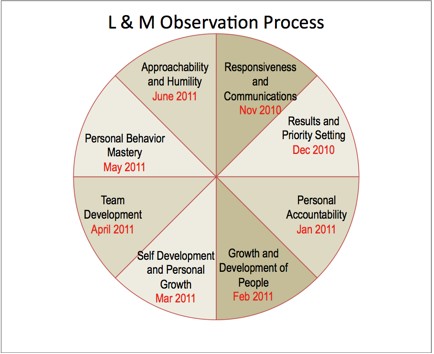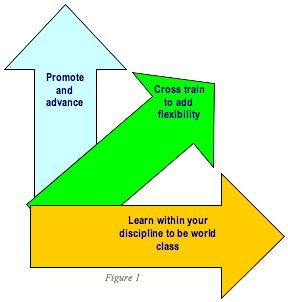Sort Articles:
Measuring Success In Leadership (Part 4): Growth and Development of People
Written by: Ralph Twombly
Published: February 2011
Growth and Development of People

Last month was the third of eight installments focused on success in leadership by introducing you to the element of Personal Accountability. If you missed January’s article on Personal Accountability or any of the first three installments click on this link: measuring_success_in_leadership_part_3.php and you can get caught up. It is February already and here we go with installment number four of eight sections in the pie above and take a look at Growth and Development of People.
 Growth/Development of People is defined as; working closely with each of the people that report to you or you are accountable for to build world class skills and behaviors. In today’s speed of light changing business environment, people in the workplace need to be working on horizontal plans (learn within your discipline to be world class), vertical strategies (advancing and becoming promotable) and/or building diagonal strength (cross train and add flexibility) see figure 1 to the right. While personal growth is the responsibility of the individual, it is the guidance and coaching of leaders that makes the growth process work. This leadership approach maximizes morale, adds effectiveness and stretches people in a way that benefits the individual and the organization. The corresponding skills and behaviors that we look at are in the table below.
Growth/Development of People is defined as; working closely with each of the people that report to you or you are accountable for to build world class skills and behaviors. In today’s speed of light changing business environment, people in the workplace need to be working on horizontal plans (learn within your discipline to be world class), vertical strategies (advancing and becoming promotable) and/or building diagonal strength (cross train and add flexibility) see figure 1 to the right. While personal growth is the responsibility of the individual, it is the guidance and coaching of leaders that makes the growth process work. This leadership approach maximizes morale, adds effectiveness and stretches people in a way that benefits the individual and the organization. The corresponding skills and behaviors that we look at are in the table below.
Skills and Behaviors Matrix
| Forced Rate: | Skill |
Behavior |
Forced Rate: |
|
Building individual growth plans |
Inspiring others to grow |
|
|
Systematically guiding people |
Encouraging people to try new things |
|
|
Setting attainable, small goals |
Trusting people |
|
|
Documentation of success and challenge |
Believing that people can achieve |
|
|
Recognizing talent and potential |
Finding success in everything |
|
Possessing the ability and willingness to help people develop is one of the unique and precious gifts of being in a position of responsibility.
As in all the previous months we use the scale of 1 being low and 5 being high and invite you to have some fun and give yourself a 1-5 rating for each skill in the left hand column and rate yourself for each behavior in the right hand column. As mentioned in previous articles if you need some help, ask others to provide some feedback. Below are the definitions for each section of the skills and behaviors matrix.
Growth and Development of People Skills Defined
| Building individual growth plans: As in this article, building growth plans is a systematic way to structure growth with the individual. There are fundamentally three parts, reviewing the past progress of the individual in regard to growth along the three arrows above, defining the current state of the persons development and determine a plan for the future that is built upon a goal or vision that benefits the individual. |
Systematically guiding people: Step by step plans make sense to people and as a leader you need to be able to build a table, chart, or even a hand written document that helps identify the first, second and third things to do. This allows people to begin, know what is next and proceed without your assistance. This is also a good discipline to pass along to others. |
Setting attainable, small goals: For some reason we feel like we need to build Rome in a day. Things are done in small bit sized chunks that are easy to achieve. There is plenty of time to ramp up and raise the bar but in the beginning it is always about small attainable steps. Smalls goals attained lead to feelings of confidence and success and as they say “success begets success.” |
Documentation of success and challenge: This is the keeping score part of development and it is critically important that leaders balance both success and challenge. We tend to look at what doesn’t work and this can discourage growth in an instant. Look for success, if only in the learning elements of the plan, and build on them. Documentation helps you make a case for the person’s continued growth and your continued investment in their growth. Without documentation, you will find that your boss less is likely to support continued investment of time and resources. |
| Recognizing talent and potential: This one could easily fit in the behavior side but we placed it here because we think that this is a skill that can be learned, refined, and taught. Spotting talent and potential requires an open mind, some vision, the nugget of a plan and the will to develop people beyond what they, or you, think possible. Winston Churchill once said; “Continuous effort - not strength or intelligence - is the key to unlocking our potential”. |
Growth and Development of People Behaviors Defined
| Inspiring others to grow: Leadership has many functions but at the very top of the list should be our ability to inspire others to do great things. Leaders who cannot do this are eventually going to be relegated to management roles. The formula for success here is part personal energy and excitement, part personal belief (you really need to believe they can) and, part farmer. Huh? Here is how it goes, you notice potential, plant the seed (the farmer part) with them that they can become extraordinary, listen to their concerns and become the advocate as they complete the work. |
Encouraging people to try new things: Fear of failure leads to fear of trying and fear of trying leads to sleep walking safely through life. The old saying goes, “no risk, no reward” which is absolutely true. If you look at the people who have attained success by anyone’s standard you will always find one common theme; they took a chance. ”The person who risks nothing, does nothing, has nothing, is nothing, and becomes nothing. He may avoid suffering and sorrow, but he simply cannot learn and feel and change and grow and love and live.” ~Leo Buscaglia |
Trusting people:The days of believing that the boss is right because he/she has positional power are at an end. In the workplace the vast majority of people want to have a voice in the work they do and the decisions that impact their lives. Years ago I learned that, if you let people set their own standards for success, they set them higher than I might. While people need to earn trust every day it is the leaders job to trust the motives, values and ideals of people until proven wrong. This is not easy because you will always be in some danger of those who will earn your distrust. “You may be deceived if you trust too much, but you will live in torment unless you trust enough.” ~Frank Crane |
| Believing that people can achieve: People constantly surprise me, no, they amaze me. These seemingly ordinary people live their lives in extraordinary ways and do amazing things. Everyday people that we (you and I) interact with, raise children with disabilities, care for returning soldiers, volunteer in soup kitchens, give time money and parts of their very souls to causes and values that would shock and humble you. The capacity of achive is hard wired into each of us whether we are 15 or 80. Most people simply need something to believe in to stretch in impressive ways. As a leader you need to believe that they can. |
Finding success in everything: Society teaches that there are winners and losers. The truth about life is that we are neither. We don’t win them all or lose them all and at the end of our days on this earth you will find that the score keeper has truly been sleeping at the switch. What we are good at is learning from our mistakes so we don’t repeat them. Again, the truth is, we need to learn from both failure and success. One gives us fear and one gives us hope and as a leader it becomes your job to make sure that balance exists for those that you lead. We like to ask, “what went wrong” when what we might ask is, “what did we learn?” We have become accustomed to punishing mistakes when what we need to do is honor the risk taker and learn something that will make life easier in the future. |
I hope you read the descriptions before you gave yourself a score in the skill and behavior categories. Next month we take a look at Self Development and Personal Growth.
As always, your feedback and examples are welcome.
Best to all,
Ralph Twombly
In the 20 years since starting Priority Learning, Ralph has facilitated countless learning experiences and has conducted training for thousands of managers and leaders. With over 30 years of leadership development and organizational development background and work, Ralph continues to build relationships with client companies all over the U.S.

